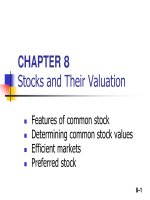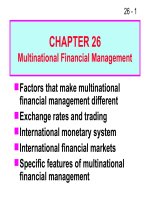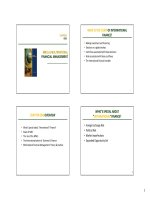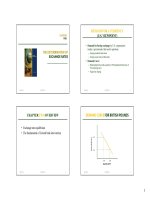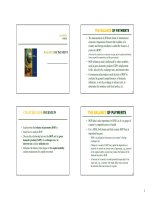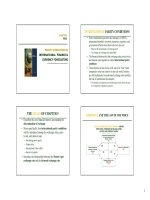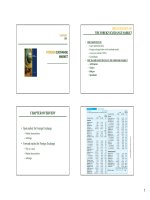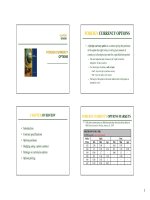Lecture Multinational financial management: Lecture 8 - Dr. Umara Noreen
Bạn đang xem bản rút gọn của tài liệu. Xem và tải ngay bản đầy đủ của tài liệu tại đây (220.58 KB, 27 trang )
Lecture
8
Government Influence
On Exchange Rates
Chapter Objectives
To describe the exchange rate
systems used by various governments;
To explain how governments can use
direct and indirect intervention to
influence exchange rates; and
To explain how government intervention in
the foreign exchange market can affect
economic conditions.
6-2
Exchange Rate Systems
• Exchange rate systems can be classified
according to the degree to which the rates
are controlled by the government:
¤ fixed
¤ freely floating
¤ managed float
¤ pegged
6-3
Fixed Exchange Rate System
System: Rates are held constant or allowed
to fluctuate within very narrow bands only.
Examples: Bretton Woods era (1944-1971),
Smithsonian Agreement (1971)
MNCs know the future exchange rates.
Governments can revalue their currencies.
Each country is also vulnerable to the
economic conditions in other countries.
6-4
Freely Floating
Exchange Rate System
System: Rates are determined by market
forces without governmental intervention.
Each country is more insulated from the
economic problems of other countries.
Central bank interventions just to control
exchange rates are not needed.
Governments are not constrained by the
need to maintain exchange rates when
setting new policies.
6-5
Freely Floating
Exchange Rate System
Less capital flow restrictions are needed,
thus enhancing market efficiency.
MNCs may need to devote substantial
resources to managing their exposure to
exchange rate fluctuations.
The country that initially experienced
economic problems (such as high
inflation, increased unemployment) may
have its problems compounded.
6-6
Managed Float
Exchange Rate System
System: Exchange rates are allowed to
move freely on a daily basis and no official
boundaries exist. However, governments
may intervene to prevent the rates from
moving too much in a certain direction.
A government may manipulate its
exchange rates such that its own country
benefits at the expense of other countries.
6-7
Pegged
Exchange Rate System
System: The currency’s value is pegged to a
foreign currency or to some unit of
account, and thus moves in line with that
currency or unit against other currencies.
Examples: European Economic
Community’s snake arrangement (1972),
European Monetary System’s exchange
rate mechanism (1979), Mexican peso’s
peg to the U.S. dollar (1994)
6-8
Currency Boards
• A currency board is a system for pegging
the value of the local currency to some
other specified currency.
Examples: HK$7.80 = US$1 (since 1983),
8.75 El Salvador colons = US$1 (2000)
A board can stabilize a currency’s value.
It is effective only if investors believe that
it will last.
6-9
Currency Boards
Local interest rates must be aligned with
the interest rates of the currency to which
the local currency is tied.
Note: The local rates may include a risk
premium.
A currency that is pegged to another
currency will have to move in tandem with
that currency against all other currencies.
6 - 10
Dollarization
• Dollarization refers to the replacement of a
foreign currency with U.S. dollars.
• Dollarization goes beyond a currency
board, as the country no longer has a
local currency.
• For example, Ecuador implemented
dollarization in 2000.
6 - 11
Exchange Rate Arrangements
Floating Rate System:
Afghanistan
Argentina
Australia
Bolivia
Brazil
Canada
Chile
Euro countries
Hungary
India
Indonesia
Israel
Jamaica
Japan
Mexico
Norway
Paraguay
Sweden
Peru
Switzerland
Poland
Taiwan
Romania
Thailand
Russia United Kingdom
Singapore
Venezuela
South Africa
South Korea
Pegged Rate System:
Bahamas
Barbados
Bermuda
China
Hong Kong
Saudi Arabia
Pegged to
U.S. dollar
6 - 12
A Single European Currency
€
• The 1991 Maastricht treaty called for a single
European currency – the euro.
• By June 2002, the national currencies of 12
European countries* had been withdrawn and
replaced with the euro.
* Austria, Belgium, Finland, France, Germany, Greece,
Ireland, Italy, Luxembourg, the Netherlands, Portugal,
Spain
• Since then, more European countries have
adopted or are planning to adopt the euro.
6 - 13
A Single European Currency
€
• The Frankfurt-based European Central
Bank is responsible for setting European
monetary policy, which is now
consolidated because of the single money
supply.
• Each participating country can still rely on
its own fiscal policy (tax and government
expenditure decisions) to help solve its
local economic problems.
6 - 14
A Single European Currency
€
• Within the euro zone, there is neither
exchange rate risk nor foreign exchange
transaction cost.
• This means more comparable product
pricing, and encourages more crossborder trade and capital flows.
• It will also be easier to conduct and
compare valuations of firms across the
participating European countries.
6 - 15
A Single European Currency
€
• The interest rates offered on government
securities will have to be similar across
the participating European countries.
• Stock and bond prices will also be more
comparable and there should be more
cross-border investing.
• However, non-European investors may not
achieve as much diversification as in the
past.
6 - 16
Status Report on the Euro
1.8
1.6
1.4
Swiss franc/€Weak €
due partly to
capital outflows
¥/€
from Europe
180
160
140
1.2
120
1
100
0.8
£/€
0.6
0.4
1/99
1/00
Relatively high
US$/€ European interest 80
rates attracted 60
capital inflows
40
1/01
1/02
1/03
1/04
6 - 17
Government Intervention
• Each country has a central bank that may
intervene in the foreign exchange market
to control its currency’s value.
• A central bank may also attempt to control
the money supply growth in its country.
• In the United States, the
Federal Reserve System (Fed)
is the central bank.
6 - 18
Government Intervention
• Central banks manage exchange rates
¤
¤
¤
to smooth exchange rate movements,
to establish implicit exchange rate
boundaries, and
to respond to temporary disturbances.
• Often, intervention is overwhelmed by
market forces. However, currency
movements may be even more volatile in
the absence of intervention.
6 - 19
Government Intervention
• Direct intervention refers to the exchange
of currencies that the central bank holds
as reserves for other currencies in the
foreign exchange market.
• Direct intervention is usually most
effective when there is a coordinated
effort among central banks and when the
central banks have high levels of reserves
that they can use.
6 - 20
Government Intervention
• When a central bank intervenes in the
foreign exchange market without adjusting
for the change in money supply, it is said
to engage in nonsterilized intervention.
• In a sterilized intervention, the central
bank simultaneously engages in offsetting
transactions in the Treasury securities
markets to maintain the money supply.
6 - 21
Government Intervention
• Some speculators attempt to determine
when the central bank is intervening
directly, and the extent of the intervention,
in order to capitalize on the anticipated
results of the intervention effort.
• Central banks can also engage in indirect
intervention by influencing the factors*
that determine the value of a currency.
* Inflation, interest rates, income level,
government controls, expectations
6 - 22
Government Intervention
• For example, the Fed may attempt to
increase interest rates (and hence boost
the dollar’s value) by reducing the U.S.
money supply.
• Some governments have also used foreign
exchange controls (such as restrictions
on currency exchange) as a form of
indirect intervention.
6 - 23
Exchange Rate Target Zones
• Target zones have been suggested for
reducing exchange rate volatility.
An initial exchange rate will be established
with specific boundaries. Ideally, the rates
will be able to adjust to economic factors
without causing fear in financial markets
and wide swings in international trade.
The actual result may be a system no
different from that which exists today.
6 - 24
Intervention as a Policy Tool
• Like tax laws and the money supply, the
exchange rate is a tool that a government
can use to achieve its desired economic
objectives.
• A weak home currency can stimulate
foreign demand for products, and hence
reduce unemployment at home. However,
it can also lead to higher inflation.
6 - 25
